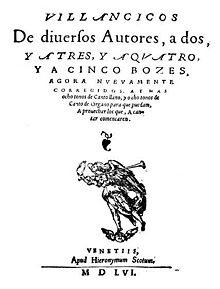Cancionero de Upsala

The Cancionero de Upsala [sic], also known by the titles Cancionero del Duque de Calabria and Cancionero de Venecia, is a volume of mostly anonymous Spanish music printed in Venice in 1556. Its actual title is Villancicos de diuersos Autores, a dos, y a tres, y a quatro, y ya a cinco bozes...Venetiis, Apud Hieronymum Scotum, MDLVI. It survives in a unique copy at the Uppsala University Library and was edited in 1909 by Rafael Mitjana; the subsequent literature has mostly adopted his spelling "Upsala" ("Upsala" being the historic Swedish spelling of "Uppsala" until the major spelling reform of 1906). A facsimile was first published by Alamire (Peer, Belgium 1984) and later by the Biblioteca Valenciana (Valencia, Spain 2003).
Contents
It is famous chiefly for the following carols or villancicos de Navidad:[citation needed]
VILLANCICOS DE NAVIDAD a 4 bozes
- Nola dovemos dormirla XXXII (These numbers and the following given in the table of contents are off by two; Nola... is actually found at p XXXIV)
- Rey aquien Reyes adoran XXXIII
- Verbum caro factum est XXXIIII
- Alta Reyna soberana XXXV
- Gozate virgen sacrada XXXVI
- Un niño nos es naçido XXXVII
- Dadme Albriçias hyo deva XXXVIII
- Yo me soy la morenica yo XXXIX
- Ela don don don XL
- Riu Riu Chiu la guarda XLI
VILLANCICOS DE NAVIDAD a 3 bozes
- Señores el ques nasçido de XLII
- Voy Virgen soys nuestra madre XLII
